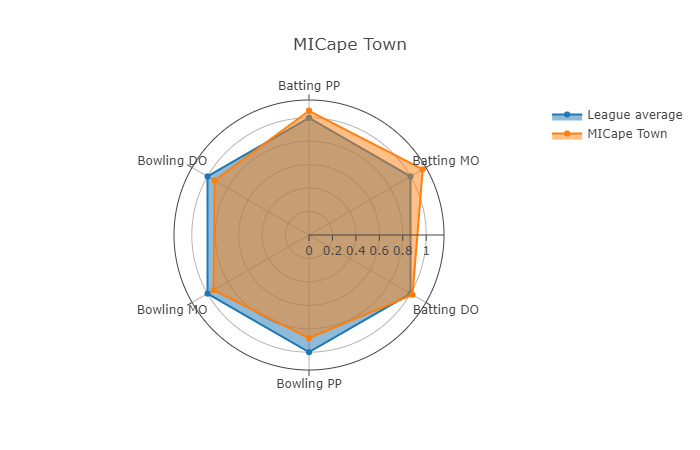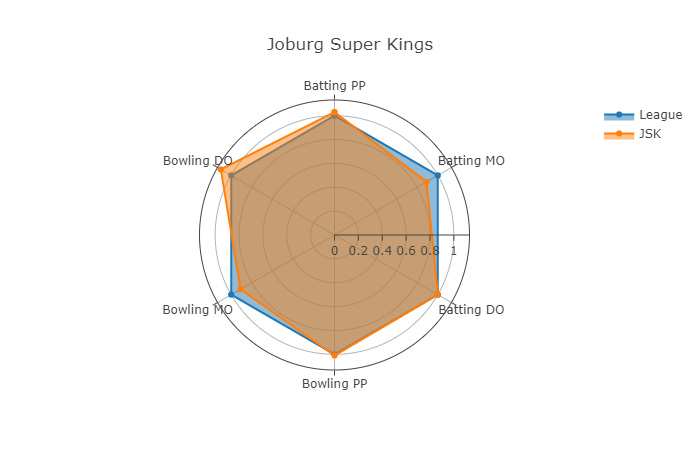Thank you for reading 438 & Beyond. If you like what you read, please click the button below, join the mailing list for FREE, and share on social media, through e-mail, or however you feel comfortable sharing.
Please consider becoming a Patron or buying a coffee to support this project and keep things going.
MICape Town
The Pretoria Capitals wanted Reeza Hendricks so bad they were ready to spend their entire purse on him. Unfortunately for them, MICape Town was also prepared to add R1 to whatever they were bidding. It didn’t make a lot of sense,
MICape Town’s opening pair, Rickelton and Van der Dussen, was the only positive thing about MICape Town’s campaign last season. They are the reason why MICape Town had the second-best powerplay, just behind the Paarl Royals, thanks to the Rickelton-Rassie partnership. They shared six partnerships worth 50 or more runs.
Between them, Rickelton and Van der Dussen were responsible for six of MICape Town’s seven half-centuries. Dewald Brevis scored the seventh. This is why Hendricks was brought in: to help solve middle-order issues.
Hendricks’ arrival points to a reconfigured 3, 4 and 5 featuring any of Van der Dussen, Brevis, Esterhuizen and Stokes. We need to backtrack a bit to show why Van der Dussen at three makes more sense: Rickelton dominated the powerplay and Van der Dussen the middle overs.
Rickelton averaged 89.3 at a strike rate of 160.5, for a true average of 61.8 and a true strike rate of 28.7, in the powerplay. Compare that to Van der Dussen’s true average of 1.6 and a true strike rate of 7.6. While he played the foil to Rickelton’s aggressive stroke play in the first six overs, Van der Dussen’s true stats shot up through the middle overs where he had a true average of 6.7 and a true strike rate of 38.8.
MICape Town’s numbers 3, 4 and 5 averaged 21.7 at 125.6. Dewald Brevis, whom they pushed around in that region, had registered the highest individual score with his 66. Sam Curran, Liam Livingstone, Kieron Pollard and Connor Esterhuizen are the other players they had in that area. Three of them, Curran, Livingstone and Pollard are no longer with the side.
And with Chris Benjamin potentially coming in at six, if and when he plays, this new batting lineup might solve MICape Town’s death batting troubles, which was their only ‘weak point’ with the bat.
MICape Town’s real issue was with the ball. A huge part of Sunrisers Eastern Cape was their bowlers’ ability to hunt in pairs - that’s why they ended up with the top three wicket-takers in the league. MICape Town needed Kagiso Rabada to do it all, in the powerplay, in the middle overs and at the death. The Rabada plan did not pan out.
In fact, it fell flat on its face so badly that Rabada finished joint 14th on the top wicket-takers list. The Proteas pacer had little to no support. Their bowling was so bad that MICT was below par in all phases of the game. They had the worst economy (9.4) in the powerplay. They were the only side that conceded at 9 or more. Their middle overs were just as bad, they had the second-worst economy, second-worst average (32.5) and second-worst strike rate (22.5).
With these two phases lost, they had no control over the death overs. It is no surprise they had the worst strike rate by a mile. They were going at 15s and the next worst team was Paarl Royals on 13.9.
A new ball partnership between Kagiso Rabada and Trent Boult cannot be compared to one between Rabada and Nuwan Thushara. The return of Rashid Khan is also a major boost for MICT.
It wouldn’t be misguided if one expected more in season 3.
MICape Town: Rashid Khan (Afghanistan), Ben Stokes (England), Kagiso Rabada, Trent Boult (New Zealand), Azmatullah Omarzai (Afghanistan), Dewald Brevis, Ryan Rickelton, George Linde, Nuwan Thushara (Sri Lanka), Connor Esterhuizen, Delano Potgieter, Rassie van der Dussen, Thomas Kaber, Chris Benjamin (England), Corbin Bosch, Colin Ingram, Reeza Hendricks, Dane Piedt, Tristan Luus (rookie).
The saying goes: everyone loves a good busker because their music creates a wonderful ambience. However, for the busker to keep busking, someone needs to put some money into the hat.
I am a busker and this is my hat:
PSA on true stats:
True stats are a contextual metric. Because when you do something in T20 makes a huge difference.
Let’s start with the true average and true strike rate: If you are a middle-order batter you are expected to have a high average since you bat in the low-risk overs. But if you’re a finisher, you have to attack from ball one and can be dismissed more often. So we factor these things in to come up with a true average.
Likewise, if you bat in the middle overs, a strike rate of 140 is really good but the same strike rate at the death is seen as very poor. It’s this difference that we account for with true strike rate.
We do the same kind of thing with the bowlers. Being economical in the middle is easy, as is taking wickets at the death. Hence, we have true economy rate and true wickets per four overs.
Joburg Super Kings
Leus du Plooy was the best thing that happened to JSK in season 2. He scored middle-order runs when no one else did and when Reeza Hendricks struggled at the top, he stepped in and ensured that the Joburg side scored powerplay runs. However, promoting Du Plooy to open with Faf du Plessis left a gaping hole in the middle order. JSK made a few runs at a slow pace. They averaged 21.48 at a strike rate of 119.8.
Whenever he was in the middle, Du Plooy looked to push the game forward and batted with the intent that JSK needed. In the powerplay, he had a true strike rate of 52.8. When he operated in the middle overs, he had a true strike rate of 8.29.
The signing of Devon Conway indicates that Stephen Fleming has chosen to bet on the Super Kings Universe’s preferred opening pair of Faf du Plessis and the New Zealander. This and the signing of Jonny Bairstow means Du Plooy will probably be sandwiched between the Conway-Du Plessis opening partnership.
That’s two of the four available overseas slots gone. So, if JSK chooses to go with that top three, they can either go with Jonny Bairstow at four or keep Moeen Ali at five. Bairstow has expressed a willingness to bat at four for England and has been doing so in domestic cricket in England. His average of 36.4 at 135.3 in that position stands him in good stead.
However, Moeen Ali’s all-round abilities give JSK better balance. Playing both leaves no room for their overseas bowlers, which isn’t something I think Fleming wants. He has quality bowlers in Maheesh Theekshana and Matheesha Pathirana. The only way Fleming can play the English duo is if he benches Du Plooy. Interesting headache for Fleming.
Last season, JSK’s five spin options delivered 277 balls in the middle overs, conceded 388 runs and took only 11 wickets. This is one of the reasons why they struggled to contain opposition teams in this phase. None of the spinners had a strike rate below 20. Their pacers did not help the situation. None of the seven seamers they deployed had a strike rate below 15 and they took only seven wickets for 386 runs in 39 overs.
These numbers are not good. They were the worst middle overs stats in the league last season. This is where they lost most of their games.
A fit Gerald Coetzee will help solve this problem. Coetzee’s bowling partnership with newly-signed Pathirana is a mouthwatering prospect. The arrival of Tabraiz Shamsi will also be a major boost to their spin department.
This is a different JSK.
Joburg Super Kings: Faf du Plessis, Moeen Ali (England), Jonny Bairstow (England), Maheesh Theekshana (Sri Lanka), Devon Conway (New Zealand), Gerald Coetzee, David Wiese (Namibia), Leus du Plooy (England), Lizaad Williams, Nandre Burger, Donovan Ferreira, Imran Tahir, Sibonelo Makhanya, Tabraiz Shamsi, Wihan Lubbe, Evan Jones, Doug Bracewell, JP King (rookie), Matheesha Pathirana (Sri Lanka)






